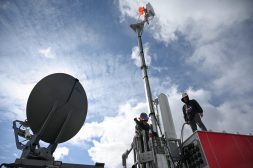Navy demos 5G for machine learning, video surveillance, zero trust and more

Pentagon and Navy officials observed an AT&T-supplied 5G network power artificial intelligence, augmented reality and machine learning and other applications at scale during a recent showcase event at Naval Base Coronado in San Diego.
Fifth-generation wireless technology refers to the latest and fastest iteration of cellular communications tools. These demonstrations come a little over a year and a half after the Defense Department announced $600 million in awards to a number of commercial partners to set up the largest full-scale 5G experimentation for dual-use applications in the world — via five U.S. military test sites.
At Naval Base Coronado, the Pentagon’s intent is to develop a 5G-enabled Smart Warehouse centered on transshipment between shore facilities and naval units.
“The DOD is running a variety of 5G-related experiments with AT&T and other vendors to explore how it may help them improve their technological advantages for the future,” Lance Spencer, client executive vice president for defense at AT&T Public Sector and FirstNet, told FedScoop on Monday. “DOD has acknowledged the need to explore and use commercial networking capabilities to avoid the enormous costs of attempting to build their own networks.”
AT&T is the only 5G network provider at this California-based experiment, but cloud solutions and applications are also being provided by other vendors.
“The AT&T 5G-powered solution we created at Naval Base Coronado is the first of its kind,” Spencer noted.
This high-performance private network solution combines spectrum, carrier-grade Radio Access Networks, roaming capabilities, enhanced cybersecurity and more.
According to Spencer, the 5G-enabled smart warehouse solution demonstrations proved the Navy and DOD “can take direct advantage of [AT&T’s] vast network of towers, fiber, equipment, and spectrum.” The various prototype use cases exhibited at the event focused on the 5G RAN and its optimization of warehouse operations through increased throughput of data, internet of things (IoT) support, and low latency.
For instance, officials from the Naval Information Warfare Center-Pacific showcased its Battlespace Exploitation of Mixed Reality (BEMR) laboratory to demonstrate how 5G-enabled virtual and augmented reality can be applied to military training, maintenance, and other applications, as well as operations.
Another video surveillance-associated demonstration entailed a high-definition camera placed in a highly secure room where critical technology infrastructure was located.
“A 5G radio was affixed to the camera to wirelessly feed video 24/7 of the room,” Spencer said.
In another separate AI and machine learning demonstration, DOD used AT&T’s 5G to connect a vendor-specific cloud environment with a camera-enabled system on module (SoM) for rapid, scenario-based customization. The SoM was optimized for industrial and supply chain environments to power shelf-stock analysis, people and object detection, and loss prevention, among other uses.
“In the demonstration, a pre-trained model was created to showcase real-time recognition and classification of polyvinyl chloride ‘elbows’ with varying degrees that were placed on a moving conveyor belt. The camera was trained to recognize different objects and update a database with the type and number of parts it recognized. The solution also collects metrics and [key performance indicators] and displays them on a dashboard for monitoring and managing operations,” Spencer explained.
He added that “another key outcome of the event was the demonstration of an operational use case of 5G-enabled Zero Trust Architecture, a strategic approach to cybersecurity that eliminates implicit trust and continuously validates every stage of digital interactions.”
Going forward, more experiments and testing aligned with different DOD priorities will unfold.
And Spencer also noted that this latest solution to be displayed is not limited to the walls of the warehouse at Naval Base Coronado.
“We expect this project to deliver seamless connectivity that allows for the tracking of Naval material end-to-end across supply chain routes. We also have the expertise to scale this capability internationally,” he said.






